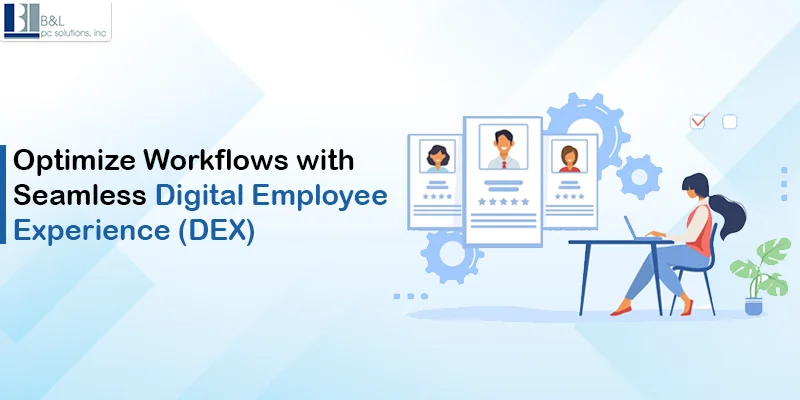
Consider the following scenario from your start in the morning: the system appears to load slowly, your collaboration tools are lagging, and IT support often takes a long time to resolve issues. Wouldn't that be so frustrating? Well, that's why the Digital Employee Experience (DEX) comes into the picture.
Nowadays, offices depend entirely on their productivity via all sorts of digital equipment. They expect outstanding access to operating systems, satisfactory communications, and quick IT support, whether in the office or remotely. A poor digital experience leads to frustration, lower productivity, and employee deterioration.
Optimizing the digital employee experience boosts productivity, reignites engagement, and equips employees with the tools to thrive. So, what does DEX mean? Let's see!
What is Digital Employee Experience DEX?
Digital Employee Experience (DEX) refers to the technology-related experiences of employees in the workplace, including software, hardware, and various IT support services connected to everyone in the organization. It covers all digital touch points employees have when carrying out daily work.
A well-designed DEX would provide users with a comfortable user experience, promoting efficient collaboration and more satisfying interactions within the organization's digital infrastructure. Characteristics include:
-
User-friendly tools that accomplish tasks quickly
-
IT support that minimizes downtime
-
Access to secure company information
-
Flexibility for remote and hybrid work
What's the Difference Between DEX and Traditional Employee Experience?
Traditional employee experience deals more with organizational culture, work environment, and company policies. Digital Employee Experience specifically refers to how well an employee interacts with the digital tools and technology they use. While this traditional experience affects morale, DEX touches on the real heart behind efficiency and job satisfaction.
The Importance of Digital Employee Experience
The key to enhancing DEX lies in research demonstrating that employee progress and uninterrupted work contribute significantly to productivity. The smooth functioning of digital tools and IT systems results in lower troubleshooting and more significant time for productivity on the part of the employees. Higher levels of employee satisfaction, lower turnover rates, and greater internal collaboration are marked among companies investing in DEX.
On the other hand, outdated or unfit systems create frustration and demotivation, affecting business growth. With investments in DEX, organizations can create an efficient workspace that encourages innovation and long-term growth. Let's dive into the importance of DEX at a glance:
1. Employee Productivity Affected
A bad digital experience stops employees from being fast. Working long hours with outdated software, constant system crashes, or mediocre support leads to a loss of efficient productivity. Studies show that companies that provide a good DEX see up to a 20% increase in employee efficiency.
2. Employee Preference and Retention
Disruptions by digital devices frustrates employees and puts them in the exit process. Employees who face regular technical problems and slow IT support would undoubtedly be on the lookout for other opportunities. On the brighter side, the companies investing in DEX keep a positive workplace environment alive, ultimately serving as the reason for retention.
3. Business Growth and Profitability
A seamless digital working experience will lead to better collaboration, informed decision-making, and higher engagement levels at the workplace, which in turn will lead to business success. Companies with optimized DEX have higher revenue growth than those who do not.
🔹A Case Study:
A Long Island law firm had slow document management systems, which hindered the casework process. Upgrading IT infrastructure and IT Managed Service Provider Long Island considerably improved the firm's document retrieval time and workflow by 43%.
The Basic Cornerstones of the DEX Strong Points
Fundamental components for a strong DEX provide employees with essential tools and skills for restorative work. From hassle-free and user-friendly IT support to strong cybersecurity significantly contributes to the overall employee experience. Organizations need a reliable IT infrastructure to enable employee collaboration and ensure employee and corporate data protection. A comprehensive DEX framework demonstrates optimized productivity and enhanced satisfaction for all-around participation. Let's see how:
1. Integrated IT Support & Infrastructure:
-
Quick response time: Employees need quick assistance from IT to be effective.
-
Proactive maintenance: Fixing IT issues before they arise is helpful for efficient workflow.
-
High-speed internet and cloud services: Employees can access systems and files almost uninterrupted.
🔹 Case Study:
An IT services company on Long Island provided 24/7 IT support for a manufacturing firm. It reduced downtime by 30% and raised employee productivity significantly.
2. Supportive Digital Tools
-
Collaborative software: Slack, Microsoft Teams, and Zoom
-
Cloud storage: Allows easy access to and safe storage of files.
-
AI Automation: It simplifies small tasks within automated workflows.
3. Cybersecurity & Compliance
-
Secure remote access through VPNs and multi-factor authentication.
-
Provides endpoint security to protect employee devices from potential threats.
-
Continued training for employees to avoid breaching confidentiality through phishing attacks.
🔹 Case Study:
A primary healthcare provider on Long Island heightened its cyber assault defenses with MFA and encrypted cloud storage to protect patient information while allowing its workforce to enjoy a hassle-free digital experience.
4. Hybrid & Remote Work Experiences
-
Flexible work environments require reliable and stable interfaces.
-
Reliable video conferencing software and secure VPN access for remote teams.
-
Mobile-friendly platforms that allow work from any location.
5. AI and Automation for Digital Workplace
-
Support Chatbots for IT and HR inquiries
-
AI analytics to predict and resolve IT issues before they occur
-
Automated workflows streamline efficiency and reduce manual errors
Measuring and Improving Digital Employee Experience
Businesses must constantly track key metrics and fine-tune digital workplace strategies to improve DEX. Important metrics include employee feedback, performance reports, technology adoption, and IT support efficiencies. Monitoring these metrics allows companies to address pain points proactively before a productivity gap becomes too large. The added elements of digital training, investment in cloud solutions, and always-on IT support enhance the employee experience. The measure offers critical data that can help make decisions to achieve long-term success. The crucial metrics include:
1. Metrics to Track DEX Success
-
Employee satisfaction surveys regarding digital tools
-
Downtime impact assessment
-
Adoption rates of collaboration tools
-
Helpdesk response and resolution times
2. Best Practices to Improve DEX
-
Providing 24/7 IT support services: Reduces downtime in businesses on Long Island
-
Investing in cloud infrastructure: Provides ease of access for employees
-
Training on digital solutions: Maximizes workplace technology adoption among employees.
Has your company's digital visitor experience hindered productivity? Managed IT services on Long Island from B&L PC Solutions can help! Schedule a free consultation today.
Actual Examples of Companies Improving DEX
-
Google- AI automation to enhance office productivity
-
IBM- Cloud solutions and IT automation in the workplace
-
A Long Island Business- Collaborated with a managed IT provider to optimize digital workflows, reducing technology-related disruptions by 50%.
Conclusion
Optimizing Digital Employee Experience (DEX) is necessary for organizations that value their employees and desire to improve productivity, satisfaction, and retention. Companies create an environment where employees will thrive with seamless IT support, simple tool use, good cybersecurity, and hybrid work flexibility.
Investing in managed IT services allows the Long Island business community to stay competitive in the digital age by helping eliminate downtime and allowing processes to run productively. Companies investing in DEX improve efficiency and prepare for future technological woes.
Does your organization have a poor digital employee experience? Contact B&L PC Solutions for top-notch IT support services on Long Island now!
Read More Blogs: Cybersecurity Services: How to Protect Your Data
FAQs About Digital Employee Experience (DEX)
1. What challenges stand in the way of improving the Digital Employee Experience?
Common challenges include slow IT support, outdated technology, security issues, and the lack of proper employee training.
2. What effect does DEX have on employee retention?
Employees become frustrated at inefficient digital experiences and will thus leave. A precise and proper digital experience means happy and engaged employees.
3. What are the best tools for improving DEX?
Popular tools are Microsoft 365, Slack, Zoom, artificial intelligence-powered automation, and cloud storage.
4. How can small businesses enhance their customer experience (DEX) without incurring significant costs?
By outsourcing IT support, investing in cloud storage, and training employees to use digital tools efficiently.
5. How does IT support improve the Digital Employee Experience (DEX)?
24/7 IT support ensures that employees can work without barriers due to technology, improving productivity and satisfaction.
Tags: Difference Between DEX and Traditional Employee Experience, Digital Employee Experience DEX, What is Digital Employee Experience DEX





